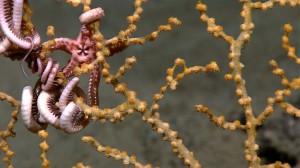Researchers continue to assess the impacts of the Deepwater Horizon oil spill on fish and wildlife, including species found deep under the sea.
For the past several years, NOAA and the Department of the Interior have joined other federal agencies to aid scientists exploring deep-sea coral habitats in the Gulf of Mexico. In late 2010, Natural Resource Damage Assessment scientists began seeing things that concerned them in an area they suspected damage from the spill was likely to have occurred. Seven miles from the site of the Deepwater Horizon wellhead—and a mile beneath the ocean's surface—they observed dead and dying corals.
Scientists used a remote-operated vehicle (ROV), the Jason II, and a deep submersible vehicle, the Alvin, to inspect the corals. They found that a large portion of two coral colonies—one hard coral and one soft coral—were covered in a brown material, and some had tissue that was falling off. The corals showed signs of tissue loss and excess mucous production. According to a recent article in the Proceedings of the National Academy of Sciences, samples taken from the coral beds matched the chemical fingerprint of the oil from the Deepwater Horizon wellhead.
Researchers will continue to study the impacts to deepwater corals and other deep-sea wildlife, and likely won't know the full extent for years to come.
NOAA has another ROV doing research in the Gulf of Mexico right now. The Little Hercules, on the NOAA vessel Okeanos Explorer, documented more than a hundred deep-sea coral colonies in the Gulf. We will continue to conduct detailed assessment of potential impacts from the oil on these corals and the animals that live on them.
You can watch the Okeanos Explorer live as it explores the deep waters of the Gulf of Mexico.


